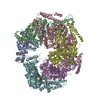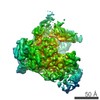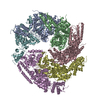+ Open data
Open data
- Basic information
Basic information
| Entry | Database: EMDB / ID: EMD-9625 | |||||||||
|---|---|---|---|---|---|---|---|---|---|---|
| Title | CryoEM Reconstruction of Hsp104 N728A Hexamer | |||||||||
 Map data Map data | Hsp104 N728A | |||||||||
 Sample Sample |
| |||||||||
 Keywords Keywords | chaperone / Hsp / holdase | |||||||||
| Function / homology |  Function and homology information Function and homology informationtrehalose metabolic process / TRC complex / protein folding in endoplasmic reticulum / cellular heat acclimation / post-translational protein targeting to endoplasmic reticulum membrane / stress granule disassembly / : / protein unfolding / nuclear periphery / ADP binding ...trehalose metabolic process / TRC complex / protein folding in endoplasmic reticulum / cellular heat acclimation / post-translational protein targeting to endoplasmic reticulum membrane / stress granule disassembly / : / protein unfolding / nuclear periphery / ADP binding / unfolded protein binding / protein-folding chaperone binding / cellular response to heat / protein refolding / ATP hydrolysis activity / ATP binding / identical protein binding / nucleus / cytosol / cytoplasm Similarity search - Function | |||||||||
| Biological species |  | |||||||||
| Method | single particle reconstruction / cryo EM / Resolution: 6.78 Å | |||||||||
 Authors Authors | Zhang X / Zhang L | |||||||||
| Funding support |  China, 1 items China, 1 items
| |||||||||
 Citation Citation |  Journal: J Biol Chem / Year: 2019 Journal: J Biol Chem / Year: 2019Title: Heat shock protein 104 (HSP104) chaperones soluble Tau via a mechanism distinct from its disaggregase activity. Authors: Xiang Zhang / Shengnan Zhang / Li Zhang / Jinxia Lu / Chunyu Zhao / Feng Luo / Dan Li / Xueming Li / Cong Liu /  Abstract: Heat shock protein 104 (HSP104) is a conserved AAA+ protein disaggregase, can disassemble the toxic aggregates formed by different amyloid proteins, and is protective in various animal models ...Heat shock protein 104 (HSP104) is a conserved AAA+ protein disaggregase, can disassemble the toxic aggregates formed by different amyloid proteins, and is protective in various animal models associated with amyloid-related diseases. Extensive studies have attempted to elucidate how HSP104 disassembles the aggregated form of clients. Here, we found that HSP104 exhibits a potent holdase activity that does not require energy, prevents the soluble form of amyloid clients from aggregating, and differs from HSP104's disaggregase activity. Using cryo-EM, NMR, and additional biophysical approaches, we found that HSP104 utilizes its small subdomain of nucleotide-binding domain 2 (ssNBD2) to capture the soluble amyloid client (K19 of Tau) independent of its ATP hydrolysis activity. Our results indicate that HSP104 utilizes two fundamental distinct mechanisms to chaperone different forms of amyloid client and highlight the important yet previously unappreciated function of ssNBD2 in chaperoning amyloid client and thereby preventing pathological aggregation. | |||||||||
| History |
|
- Structure visualization
Structure visualization
| Movie |
 Movie viewer Movie viewer |
|---|---|
| Structure viewer | EM map:  SurfView SurfView Molmil Molmil Jmol/JSmol Jmol/JSmol |
- Downloads & links
Downloads & links
-EMDB archive
| Map data |  emd_9625.map.gz emd_9625.map.gz | 4.5 MB |  EMDB map data format EMDB map data format | |
|---|---|---|---|---|
| Header (meta data) |  emd-9625-v30.xml emd-9625-v30.xml emd-9625.xml emd-9625.xml | 19 KB 19 KB | Display Display |  EMDB header EMDB header |
| Images |  emd_9625.png emd_9625.png | 88.4 KB | ||
| Masks |  emd_9625_msk_1.map emd_9625_msk_1.map | 4.8 MB |  Mask map Mask map | |
| Filedesc metadata |  emd-9625.cif.gz emd-9625.cif.gz | 6.8 KB | ||
| Others |  emd_9625_half_map_1.map.gz emd_9625_half_map_1.map.gz emd_9625_half_map_2.map.gz emd_9625_half_map_2.map.gz | 3.5 MB 3.5 MB | ||
| Archive directory |  http://ftp.pdbj.org/pub/emdb/structures/EMD-9625 http://ftp.pdbj.org/pub/emdb/structures/EMD-9625 ftp://ftp.pdbj.org/pub/emdb/structures/EMD-9625 ftp://ftp.pdbj.org/pub/emdb/structures/EMD-9625 | HTTPS FTP |
-Validation report
| Summary document |  emd_9625_validation.pdf.gz emd_9625_validation.pdf.gz | 782.4 KB | Display |  EMDB validaton report EMDB validaton report |
|---|---|---|---|---|
| Full document |  emd_9625_full_validation.pdf.gz emd_9625_full_validation.pdf.gz | 781.9 KB | Display | |
| Data in XML |  emd_9625_validation.xml.gz emd_9625_validation.xml.gz | 8 KB | Display | |
| Data in CIF |  emd_9625_validation.cif.gz emd_9625_validation.cif.gz | 9.4 KB | Display | |
| Arichive directory |  https://ftp.pdbj.org/pub/emdb/validation_reports/EMD-9625 https://ftp.pdbj.org/pub/emdb/validation_reports/EMD-9625 ftp://ftp.pdbj.org/pub/emdb/validation_reports/EMD-9625 ftp://ftp.pdbj.org/pub/emdb/validation_reports/EMD-9625 | HTTPS FTP |
-Related structure data
| Related structure data | 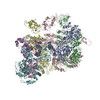 6ahfMC M: atomic model generated by this map C: citing same article ( |
|---|---|
| Similar structure data |
- Links
Links
| EMDB pages |  EMDB (EBI/PDBe) / EMDB (EBI/PDBe) /  EMDataResource EMDataResource |
|---|---|
| Related items in Molecule of the Month |
- Map
Map
| File |  Download / File: emd_9625.map.gz / Format: CCP4 / Size: 4.8 MB / Type: IMAGE STORED AS FLOATING POINT NUMBER (4 BYTES) Download / File: emd_9625.map.gz / Format: CCP4 / Size: 4.8 MB / Type: IMAGE STORED AS FLOATING POINT NUMBER (4 BYTES) | ||||||||||||||||||||||||||||||||||||||||||||||||||||||||||||||||||||
|---|---|---|---|---|---|---|---|---|---|---|---|---|---|---|---|---|---|---|---|---|---|---|---|---|---|---|---|---|---|---|---|---|---|---|---|---|---|---|---|---|---|---|---|---|---|---|---|---|---|---|---|---|---|---|---|---|---|---|---|---|---|---|---|---|---|---|---|---|---|
| Annotation | Hsp104 N728A | ||||||||||||||||||||||||||||||||||||||||||||||||||||||||||||||||||||
| Voxel size | X=Y=Z: 2.64 Å | ||||||||||||||||||||||||||||||||||||||||||||||||||||||||||||||||||||
| Density |
| ||||||||||||||||||||||||||||||||||||||||||||||||||||||||||||||||||||
| Symmetry | Space group: 1 | ||||||||||||||||||||||||||||||||||||||||||||||||||||||||||||||||||||
| Details | EMDB XML:
CCP4 map header:
| ||||||||||||||||||||||||||||||||||||||||||||||||||||||||||||||||||||
-Supplemental data
- Sample components
Sample components
-Entire : CryoEM Reconstruction of Hsp104 N728A Hexamer
| Entire | Name: CryoEM Reconstruction of Hsp104 N728A Hexamer |
|---|---|
| Components |
|
-Supramolecule #1: CryoEM Reconstruction of Hsp104 N728A Hexamer
| Supramolecule | Name: CryoEM Reconstruction of Hsp104 N728A Hexamer / type: complex / ID: 1 / Parent: 0 / Macromolecule list: #1 |
|---|---|
| Source (natural) | Organism:  |
-Macromolecule #1: Heat shock protein 104
| Macromolecule | Name: Heat shock protein 104 / type: protein_or_peptide / ID: 1 / Number of copies: 6 / Enantiomer: LEVO |
|---|---|
| Source (natural) | Organism:  |
| Molecular weight | Theoretical: 102.130938 KDa |
| Recombinant expression | Organism:  |
| Sequence | String: MNDQTQFTER ALTILTLAQK LASDHQHPQL QPIHILAAFI ETPEDGSVPY LQNLIEKGRY DYDLFKKVVN RNLVRIPQQQ PAPAEITPS YALGKVLQDA AKIQKQQKDS FIAQDHILFA LFNDSSIQQI FKEAQVDIEA IKQQALELRG NTRIDSRGAD T NTPLEYLS ...String: MNDQTQFTER ALTILTLAQK LASDHQHPQL QPIHILAAFI ETPEDGSVPY LQNLIEKGRY DYDLFKKVVN RNLVRIPQQQ PAPAEITPS YALGKVLQDA AKIQKQQKDS FIAQDHILFA LFNDSSIQQI FKEAQVDIEA IKQQALELRG NTRIDSRGAD T NTPLEYLS KYAIDMTEQA RQGKLDPVIG REEEIRSTIR VLARRIKSNP CLIGEPGIGK TAIIEGVAQR IIDDDVPTIL QG AKLFSLD LAALTAGAKY KGDFEERFKG VLKEIEESKT LIVLFIDEIH MLMGNGKDDA ANILKPALSR GQLKVIGATT NNE YRSIVE KDGAFERRFQ KIEVAEPSVR QTVAILRGLQ PKYEIHHGVR ILDSALVTAA QLAKRYLPYR RLPDSALDLV DISC AGVAV ARDSKPEELD SKERQLQLIQ VEIKALERDE DADSTTKDRL KLARQKEASL QEELEPLRQR YNEEKHGHEE LTQAK KKLD ELENKALDAE RRYDTATAAD LRYFAIPDIK KQIEKLEDQV AEEERRAGAN SMIQNVVDSD TISETAARLT GIPVKK LSE SENEKLIHME RDLSSEVVGQ MDAIKAVSNA VRLSRSGLAN PRQPASFLFL GLSGSGKTEL AKKVAGFLFN DEDMMIR VD CSELSEKYAV SKLLGTTAGY VGYDEGGFLT NQLQYKPYSV LLFDEVEKAH PDVLTVMLQM LDDGRITSGQ GKTIDCSN C IVIMTSALGA EFINSQQGSK IQESTKNLVM GAVRQHFRPE FLNRISSIVI FNKLSRKAIH KIVDIRLKEI EERFEQNDK HYKLNLTQEA KDFLAKYGYS DDMGARPLNR LIQNEILNKL ALRILKNEIK DKETVNVVLK KGKSRDENVP EEAEECLEVL PNHEATIGA DTLGDDDNED SMEIDDDLD UniProtKB: Heat shock protein 104 |
-Macromolecule #2: PHOSPHOTHIOPHOSPHORIC ACID-ADENYLATE ESTER
| Macromolecule | Name: PHOSPHOTHIOPHOSPHORIC ACID-ADENYLATE ESTER / type: ligand / ID: 2 / Number of copies: 6 / Formula: AGS |
|---|---|
| Molecular weight | Theoretical: 523.247 Da |
| Chemical component information | 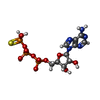 ChemComp-AGS: |
-Experimental details
-Structure determination
| Method | cryo EM |
|---|---|
 Processing Processing | single particle reconstruction |
| Aggregation state | particle |
- Sample preparation
Sample preparation
| Buffer | pH: 7.4 |
|---|---|
| Grid | Model: Quantifoil R1.2/1.3 / Material: COPPER |
| Vitrification | Cryogen name: ETHANE / Chamber humidity: 100 % |
- Electron microscopy
Electron microscopy
| Microscope | FEI TITAN KRIOS |
|---|---|
| Image recording | Film or detector model: GATAN K2 SUMMIT (4k x 4k) / Average electron dose: 50.0 e/Å2 |
| Electron beam | Acceleration voltage: 300 kV / Electron source:  FIELD EMISSION GUN FIELD EMISSION GUN |
| Electron optics | Illumination mode: OTHER / Imaging mode: OTHER |
| Sample stage | Cooling holder cryogen: NITROGEN |
| Experimental equipment |  Model: Titan Krios / Image courtesy: FEI Company |
 Movie
Movie Controller
Controller



